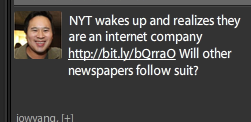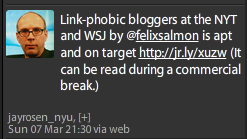While I generally don’t like the dismissive attitude embodied in the assertion that a person or organization doesn’t “get” something, a couple of recent tweets relating to the New York Times and social media make me at least ask the question.
As I was checking my Tweetdeck on the bus this morning, I noted this tweet from Jeremiah Owyang (@jowyang):
…which linked to this article about the NY Times hiring 12 techies and a social media whiz. That was encouraging to read, but as I scrolled down a bit through last night’s #Oscars tweets I came across this one from Jay Rosen (@jayrosen_NYU):
…which linked to this post about the reasons behind a plagiarism problem at the Times, and how the culture there and at the Wall Street Journal is antithetical to the world of social media. Felix Salmon’s (@felixsalmon) post (to which I have added emphasis) begins as follows:
Clark Hoyt, the NYT’s public editor, has a good post-mortem on l’affaire Zachary Kouwe, and asks whether “the culture of DealBook, the hyper-competitive news blog on which Kouwe worked” was partly to blame for his plagiarism.
It’s a good question, but also a dangerous one, because I fear it will help to keep blogs marginalized at the NYT and elsewhere: is there something inherent to the culture of blogging which breeds a degree of carelessness ill suited to a venerable newspaper?
The answer, in truth, is not that the NYT has gone too far down the bloggish rabbit hole, but rather that it hasn’t gone far enough. Kouwe was a reporter for the newspaper as well as for Dealbook, and as far as I know he has never had a blog of his own before or since. Big mainstream-media publications, when they hire people to write their blogs, generally hire people with no blogging experience at all — something which is both ill-conceived and dangerous. Some journalists make good bloggers; most don’t. So rather than gamble that you’ve found one of the rare exceptions, why not make prior blogging experience a prerequisite for such positions?
The fundamental problem with Kouwe was that when he saw good stories elsewhere, he felt the need to re-report them himself, rather than simply linking to what he had found, as any real blogger would do as a matter of course.
I hope the actions highlighted in Jeremiah’s tweet mean that the Times will begin to change its approach and will start linking externally. Bringing in some fresh people who don’t have the print reporter mindset may help. But if the paper’s policy against linking externally remains, it will hasten the Times‘ decline, for two reasons:
- There will inevitably be additional plagiarism incidents, as print culture tries (and fails) to keep up with the speed of the Web. This will lead to further embarrassment and reduced respect for the Times.
- By trying to re-write everything (to avoid linking), the Times will be wasting effort to be later with its reports than it would be if it immediately linked. So people will go elsewhere for timely news.
This post took less than half an hour on the bus. I could have tried to rewrite arguments, but what good would that have done? Excerpting and linking is both the right thing to do and the smart thing to do. It’s wasteful for print media to expend so much energy to avoid giving other people credit.
Hopefully the new social media whiz the Times is hiring will help management understand that.



